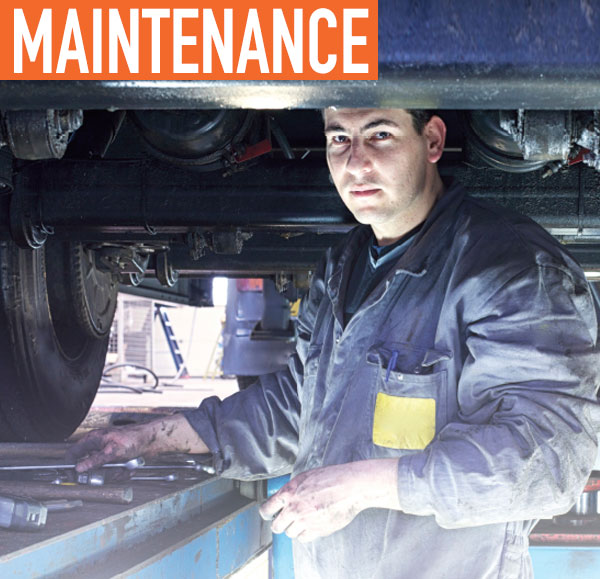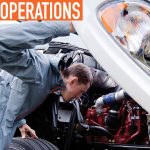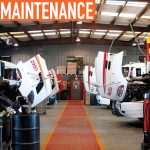Equipment maintenance helps keep your truck’s mobile power equipment up and running. It can help owners, end-users, and operators with building our world and making a living. Both proper maintenance and scheduled maintenance are needed to ensure the mobile power system and power take-off (PTO) are running as trouble-free as possible.
THE PROCESS
The maintenance process can be broken down into several brackets: the initial stage, short term, long term, and system stages. There is also a duty-cycle phase to consider. All of these require planning, along with knowledge of the mobile power system and a good understanding of the operational side of the equipment. Keep those ideas in mind as you plan your tasks.
SAFETY FIRST
Before any work is done, a few safety precautions must be observed. First, make sure you follow your company’s safety practices and procedures. Do not get under a truck with the engine running or with the system engaged. Rotating components can be dangerous. Remove the keys from the ignition and store them in a safe place so the truck cannot be started accidently. Also, ensure the vehicle is not moving or able to move. Use wheel chocks if need be. Read and follow any warning decals or precautions before starting any work. Lastly, it is a good practice to let the engine cool down so no one gets burnt by hot parts or fluids.

Bearings should be packed with grease before installation.
INITIAL STAGES
In the beginning, maintenance should be conducted in the first few days after starting up the system and engaging the PTO. Listen to the system. Make a mental note of the sound coming from the truck’s drivetrain before the installation and after. After the system and PTO have warmed up for a short period, they should be shut down and inspected.
How did the system sound? A noisy powertrain can be a sign of high backlash, poor bolt torque, wrong gaskets, or low fluids. So, if there is a lot of unusual noise, the best practice is to investigate the issues before putting the vehicle back on the road. Lastly, after it is cooled down, check the hardware and re-torque the PTO mounting hardware—as required—to OEM specifications.

This is an example of new replacement gears.
SHORT TERM
The short-term stage is commonly called weekly review. At this point, the truck and system have been used quite a bit. The PTO and other parts have been heated up, cooled down, and used for some longer period of time. By now, it is fair to state the vehicle has experienced its normal duty-cycle. This is an ideal time to schedule an inspection. The simple inspection is to look for leaks, check noise, air leaks, examine fluid levels, look for loose items, and ensure the hardware is still tight.
It is vital to listen to the system. How does it sound? Has anything changed from the initial stage? If you investigate further and address any noise variance that arises, chances are, you’ll avoid a small issue turning into something bigger and more costly. Noise is a key to finding gear damage, which needs to be addressed. Some trucks have indicator lights in the cab. If they happen to light up unexpectedly, use them to troubleshoot per the OEM guidelines. This will also help you get more familiar with your set up and make future inspections go quicker.

This is a sample of a seal properly seated, in place, over the lightly greased shaft.
LONG TERM
Performing long-term maintenance is simple and is typically tied to regular vehicle OEM maintenance or transmission tasks. Your maintenance person should consider the PTO as an extension of the transmission. These highly engineered, well-designed products are built to last. When fluids are checked on the transmission, look at the PTO. Consider this short list:
- Look for broken wires
- Check for leaks
- Check to make sure no parts are loose
- Verify hardware is properly tight
If anything needs to be repaired or replaced, do so immediately. For example, if the fluid is dirty, change it; if fluid is low, fill it to the proper level; and/or if there is a leak, consider replacing the appropriate seal or gaskets.
More importantly, listen for unusual drivetrain sounds. Listen for notable problems. This can be a good time to check gear backlash. Verify the backlash is within the acceptable tolerance. While checking the backlash, take the time to look at the gears. A high wattage shop light may be a good idea to help look for nicks, pitting, and excessive wear.
If need be, you can remove the PTO from the transmission for a more detailed inspection of the transmission gear and PTO gear set. Based on what you find, repair, fix, and replace, as needed. Worn or pitted gears should be replaced. A reputable OEM will have a kit to help do this. Note: If gears are being replaced, you should inspect seals and bearings. Remember to pack bearings with a good grease.

DUTY-CYCLE
After some time has passed and the early stages of preventive maintenance are completed, it is a good time to think about how to set up maintenance based on your duty-cycle. There are two types of duty-cycles: intermittent and continuous. More simply put, light work or heavy workloads.
If a PTO is used less than five minutes at a time, a few times per day, it is considered intermittent. On the other hand, if the system is used five minutes or more in a 15-minute time span, it is called continuous-duty. A continuous-duty system will likely require more inspections and maintenance than intermittent-duty systems. Maintenance professionals will adjust their schedule accordingly, based on the truck’s duty-cycle.
VEHICLE MAINTENANCE
Just a short note to highlight OEM vehicle maintenance: Anytime the vehicle is in for normal repair and maintenance, whether it be for brakes, wheels, engine, or chassis, take the time to add in a mobile power system inspection. Anytime the vehicle is in the shop, check PTO fluids, torque, pneumatic lines, seals, and listen for odd noise. Then, take the appropriate steps to fix anything you may discover. You might find a loose wire, you might find an air line leaking, and sometimes it may be as simple as pulling the pump from the PTO, cleaning it, and applying fresh grease.
ABOUT THE AUTHOR:
Mikel Janitz is an OEM applications engineer for Bezares USA, a global leader in PTO engineering & design. Mikel graduated from Oklahoma State University with a BS and MS in Engineering/Management. He works in Tulsa, Oklahoma, and holds several patents. Mikel can be reached by email: m.janitz@bezares.com.
_______________________________________________________________________
MODERN WORKTRUCK SOLUTIONS: APRIL 2016 ISSUE
Did you enjoy this article?
Subscribe to the FREE Digital Edition of Modern WorkTruck Solutions magazine.
![]()




